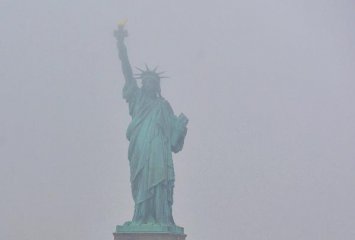WASHINGTON, May 30 (Xinhua) -- The U.S. economic growth in the first quarter of 2019 was revised down to an annual rate of 3.1 percent, from the previously reported 3.2 percent, the U.S. Commerce Department said Thursday in its second estimate.
The update of the gross domestic product (GDP) growth reflected downward revisions to business investment and inventory investment and an upward revision to imports, the department said in a report, adding that these revisions were partly offset by upward revisions to exports and consumer spending.
Nonresidential fixed investment in the first quarter was revised down to an annual rate of 2.3 percent, from the previous estimate of 2.7 percent, according to the data released by the Bureau of Economic Analysis. It rose by 5.4 percent in the fourth quarter of 2018.
Imports in the first quarter shrank by 2.5 percent, compared with 3.7 percent in a previous estimate. Exports, meanwhile, were up 4.8 percent in the first quarter, compared with 3.7 percent in the previous estimate.
Growth in consumer spending, which accounts for more than two-thirds of U.S. economic output, was revised up to 1.3 percent, from 1.2 percent in a previous estimate. Consumer spending grew by 2.5 percent in the previous quarter.
The 3.1-percent annual growth rate in the first quarter indicated an acceleration of economic expansion, considering the annual rate of 2.2 percent in the fourth quarter of 2018. The pickup is mostly driven by strong exports and private inventory investment.
Data showed that net exports contributed 0.96 percentage point to the quarter's GDP gain, and change in private inventories contributed 0.60 percentage point.
The new report also showed that the price index for personal consumption expenditures (PCE) was revised down to 0.4 percent, compared with a rise of 1.5 percent in the previous quarter. Excluding food and energy prices, the "core" PCE price index, the Federal Reserve's preferred inflation measure, was trimmed to 1.0 percent, compared with 1.8 percent in the previous quarter.
Weaker than expected inflation could add pressure on the Fed to reassess its monetary policy, as the central bank has set a target of 2 percent annual gain for the PCE price index.
Federal Reserve Vice Chairman Richard Clarida, however, reaffirmed the Fed's current policy stance on Thursday, saying that officials expect some of the recent inflation softness to be "transitory."
Clarida, who made the remarks during a discussion in New York, said the Fed is attuned to potential risks to the economic outlook. "If we saw a downside risk to the outlook, then that would be a factor that could call for a more accommodative policy."
The U.S. economy expanded 2.9 percent last year, falling short of the administration's 3 percent target. With fading effect of the tax cuts and growing U.S.-initiated trade frictions, the U.S. economy is expected to slow down this year.
According to the report, adjusted corporate profits fell by 2.8 percent at an annual pace in the first quarter, following a 0.4-percent decline in the previous quarter, which is considered a negative signal for the economy.
In its latest economic projections released in March, the U.S. central bank cut its forecast of the economic growth for 2019 and 2020, expecting a rate of 2.1 percent and 1.9 percent, respectively.
In its new edition of the World Economic Outlook released in April, the International Monetary Fund also downgraded the growth forecast for the U.S. economy, expecting it to slow to 2.3 percent in 2019, down 0.2 percentage point compared with its January estimate.























Latest comments